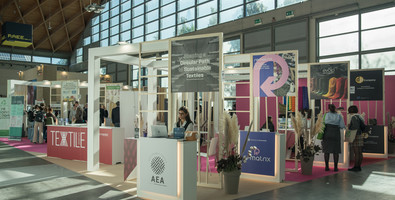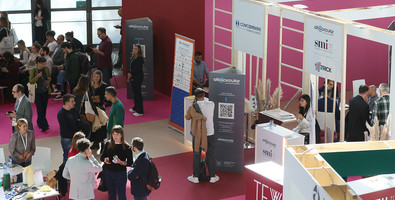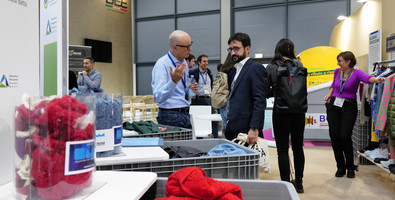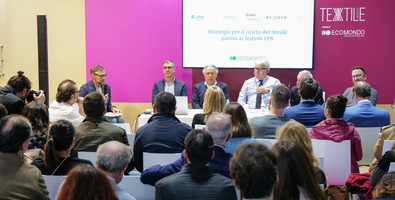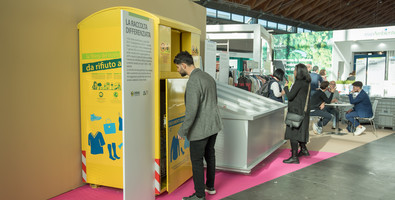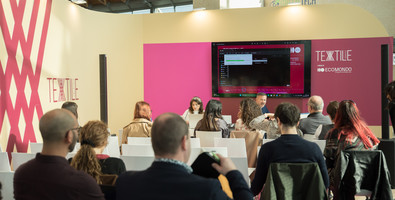Textile District
From separate waste collection to re-use, from recycling to eco-design up to fashion renting and second hand: the Textile District, now in its 4th edition, is a candidate for Ecomondo as the capital of ethical fashion thanks to an exhibition space involving all the players in the supply chain and a rich programme of events aimed at catalysing attention towards a more sustainable model for the sector.
A project of great importance if we consider that textiles have been identified as a key value chain, for which the European Union has planned actions to promote sustainability, circularity, traceability and transparency.
An area of exchange where we can take stock of the circularity of fibres and technologies, chemical protocols, EPR regulations, greenwashing, the right to reparability, digital passports... thanks to the involvement of the main stakeholders in the supply chain and a dedicated conference schedule.
WHO EXHIBIT
The Textile District involves companies active in:
>> PRODUCTION, ECO-DESIGN
yarns, fabrics, clothing, footwear, accessories, leather goods, upholstery textiles
>> INDUSTRIAL WASTE VALORISATION
production waste, process management
>> WASTE MANAGEMENT
municipal and industrial waste collection, multi utilities, cooperatives
>> SELECTION AND TREATMENT, VALORISATION
reuse, pre and post-consumer sorting, treatment and recycling plants, reuse and second-hand
>> R&D CENTRES, CERTIFIERS, START-UPS
traceability systems, technological innovation
>> CONSORTIA, TRADE ASSOCIATIONS
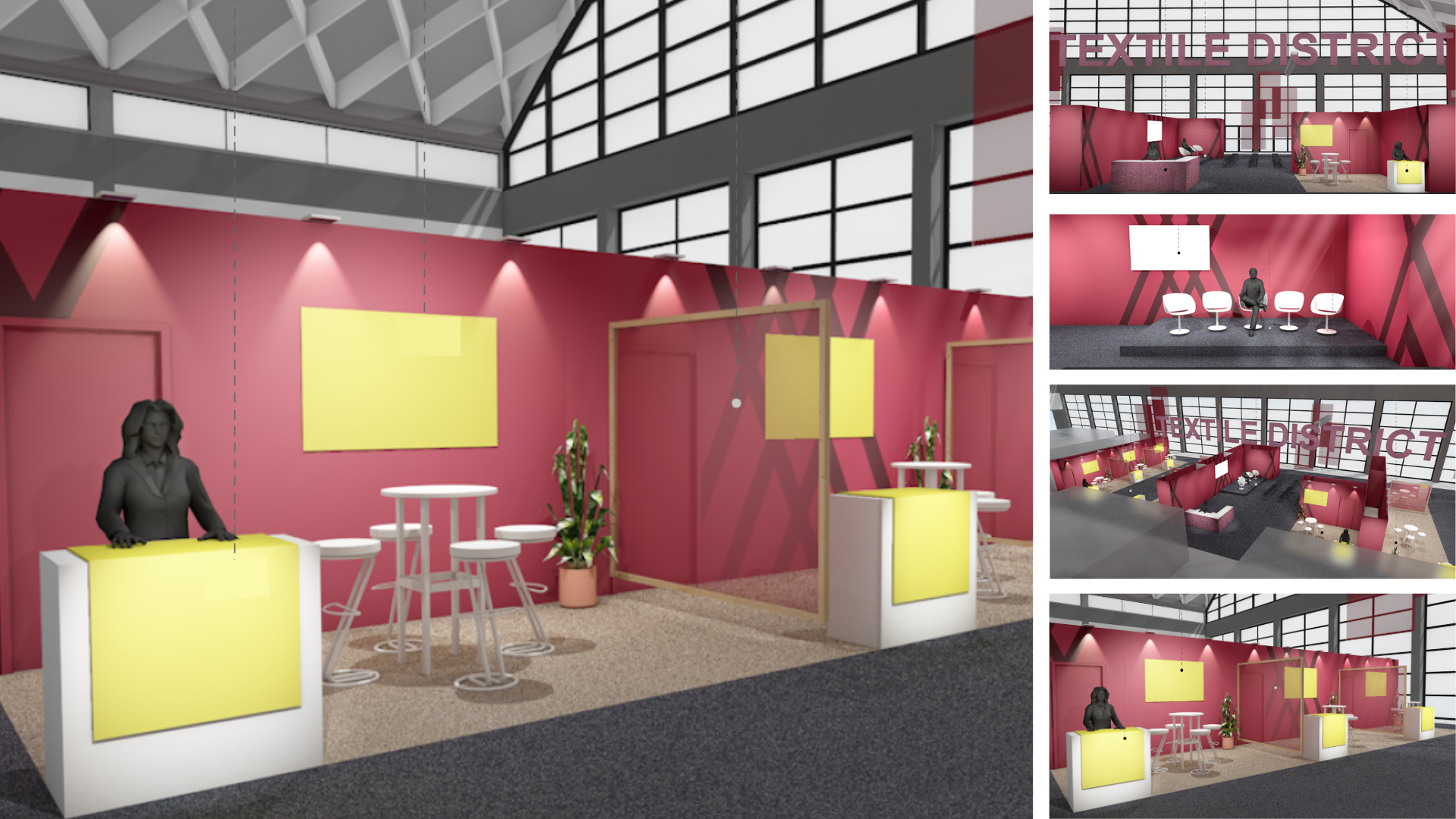
*Restituzione Grafica Textile District 2024, il progetto può subire variazioni
THE EXHIBITION PROJECT
The Textile District occupies a significant portion of Hall B3. There will be companies from the supply chain present with their own stand in the bare area, flanked by a project area that will host about 15 companies and will provide a workshop room for conferences, talks and seminars.
PROJECT AREA
characterised by free-standing stands, with an organisational set-up and fully equipped spaces. Area membership includes:
>> 17 OR 21 SQM STAND MODULES
with: desk, furnished meeting space and dedicated storage space, welcome desk and wall graphics
>> SERVICES
cleaning, reception, lead scanner for profiled database generation, free dedicated invitation ticket for your customers, exhibitor badges, car passes
>> CONFERENCE HALL
70 seats with technical assistance, monitors, hostesses
>> GRAPHIC DESIGN
organic graphicisation of the entire space, a series of hangings and signage strategically distributed within the fairground to increase visitation
>> ADV CAMPAIGN
dedicated on vertical sector media, website page that will give space to the profile of exhibiting companies and coverage in the Ecomondo communication
CONFERENCES AND CONTENT
The textile sector is also one of the highlights of the Ecomondo conference programme.
Vertical conferences will be organised in the workshop area on the following topics: sustainability and eco-design, organic waste management: collection, sorting, reuse and recycling, ERP and EOW, export of urban and second-hand textile waste, traceability and digital passport and green washing. These will be complemented by talks presented by companies in the district.
SCENARIO: THE IMPORTANCE OF THE TEXTILE INDUSTRY IN ITALY AND ABROAD
The fashion industry, besides being one of the pillars of the European economy, represents one of the sectors with the highest environmental impact. In fact, it is a supply chain comprising 400 thousand businesses that generates a turnover of 55 billion euros, equal to 31% of the total turnover in Europe.
But it is also one of the supply chains that produce the most pollution on the planet. In fact, it is responsible for 10% of global carbon emissions, consumes around 93 billion metric cubic metres of water in production alone and dumps around 500,000 tonnes of microfibres into the seas. Not to mention that the production of textiles almost doubled between 2020 and 2015, and garment consumption is also estimated to grow by a further 63% by 2030*.
*Source European Commission
Not only water consumption and emitted carbon footprint, the textile industry makes use of polluting chemicals that are an obstacle to the recycling of raw materials, with the result that natural fibres are becoming increasingly rare and costly, driving major brands to search for recyclable fibres and cleaner production processes.
All these considerations, combined with the fact that garment production generates a massive amount of textile waste along the supply chains but also at industrial and consumer level, the aim at Ecomondo is to take stock of circularity, sustainably produced fibres and technologies for recycling and safer chemical protocols, taking up the objectives and that the European Union has set itself.
‘By 2030, textile products placed on the EU market will be durable and recyclable, largely made of recycled fibres, free of hazardous substances and produced with respect for social rights and the environment’.
This is the promise of the EU Strategy for Sustainable and Circular Textiles, a strategy that is part of the Sustainable Product Initiative (SPI) package of proposals published by the European Commission.
In this scenario, the key words for the green reconversion of fashion are recyclability of garments (today only 1% of textile waste is reused, and 85% of production ends up in landfills), eco-design (and shared regulations to track its parameters), transparency and control of the supply chain. The education of all stakeholders also becomes an important catalyst in this process, to involve not only production and distribution but also consumers who, with their purchasing choices, play an extremely important role in guiding the industry.
CONTACT US
Silvia Gabellini


